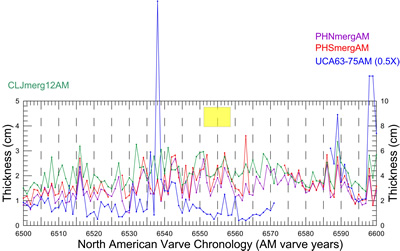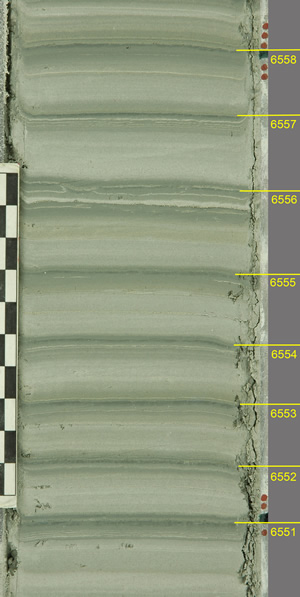Varves of the Month for 12/1/2011 - 2/29/2012
Connecticut Valley Varves at Claremont Junction, NH
This image shows ice-distal varves from a drill hole at Claremont Junction in the Connecticut Valley of south-central New Hampshire. The top of each varve is labeled with its annual number in the new North American Varve Chronology (NAVC). These varves were deposited about 280 years after ice recession at Claremont Junction when the receding ice margin was 75 km to the north near Bradford, Vermont. The varves shown here are about 14,300 yr old. The varves at Claremont Junction very closely match other varve sections (see graph) from North Charlestown, NH and a record compiled by Ernst Antevs (1922) further north in the Connecticut Valley. To see the matching of varve sections from across New England for the whole NAVC go to: NAVC Master Plots.

A correlation of the varve record from Claremont Junction (CLJmerg12AM) with other varve records in the interval of the core image (yellow indicates core's time interval). Other records are from drill sites in the Perry Hill basin in North Charlestown, NH (PHNmergAM and PHSmergAM) and an original record of Antevs (1922; UCA63-75AM) that are all plotted with annual years of the North American Varve Chronology. The drill site records (CLJ, PHN, PHS) are the result of the merging and averaging of varve records from two side by side cores at each site. The Claremont Junction record is plotted on the thickness axis to the left while the others are plotted on the right axis with the Antevs record plotted at a scale of 0.5X. In the interval between 6530 and 6575 none of the varve records match each other very well but they all have a consistent varve count across this interval and join earlier and later intervals where the records match very well. Click to download full resolution version (~1 MB JPG).
The pattern of sedimentation was complex, being controlled by both glacial and non-glacial (meteoric) processes. Varve thickness was controlled by glacial meltwater activity as meltwater moved south away from the glacier but also pulses of sediment from a river in the Sugar River valley that built a large delta where it enters the Connecticut Valley about a kilometer to the east of the Claremont Junction site. The varves shown here are much thinner than varves lower in the sequence that were deposited when the receding ice front was much closer and much more sediment was deposited directly from a glacial source.
Summer or melt season layers (light-colored units) are composed of a stack of micrograded units of fine sand and silt. Even though the varves shown here are distal to the glacier they show subdivisions of the summer layer that are usually more distinct in thicker ice-proximal varves. The summer layers have a lower early melt season unit that is darker than the center of the summer layer and they also grade into darker silt units at the top of the summer layer marking a late melt season unit. This pattern is most distinct in varves 6552-6554 and 6558 but occurs in all of the varves on this image. Occasionally there are subtle fine sand layers within the summer layers that represent an influx of sandy sediment from tributaries during rainstorm or land surface snowmelt events (for example in 6555 and 6558).
Summer layers appear to grade into their overlying winter layers. Gradation from summer to winter is reflected by many fine sand and silt partings that interbed with silty clay near the bottoms of the winter layers suggesting that clay and fine silt settling is initiated before the close of the melt season when melting or rainstorm events, and perhaps diurnal meltwater pulses can still disperse coarser silt and fine sand across the lake floor for brief intervals. The highly rhythmic nature of thin units within the very top of the summer layers and grading into the winter layers is suggestive of diurnal variations in deposition, especially in varves 6551 and 6557. Summer layer thickness in this sequence is much greater than winter layer thickness and also varies much more than winter layer thickness. In this image summer layer thickness appears to vary independent of the thickness of the very thin winter layers, which are relatively uniform.
Another interesting feature of the varves shown here is the depression that interrupts the winter layer of varve 6556 and is filled in by summer sediment from varve 6557. In outcrop exposures features like this often represent large trails (trace fossils) left on the bedding plane by organisms such as fish or crustaceans. For more information on trace fossils in varves see the reference list below.
- Benner, J.S., Ridge, J.C., and Knecht, R.J., 2009, Timing of post-glacial reinhabitation and ecological development of two New England, USA, drainages based on trace fossil evidence: Palaeogeography, Palaeoclimatology, Palaeoecology, v. 272, p. 212-231. Doi:10.1016/j.palaeo.2008.10.029
- Benner, J.S., Ridge, J.C., and Taft, N.K., 2008, Late Pleistocene freshwater fish (Cottidae) trackways from New England (USA) glacial lakes and a reinterpretation of the ichnogenus Broomichnium Kuhn: Palaeogeography, Palaeoclimatology, Palaeoecology, v. 260, no. 3-4, p. 375-388. doi:10.1016/j.palaeo.2007.12.00
- Knecht, R.J., Benner, J.S., Rogers, D.C., and Ridge, J.C., 2009, Surlichnus bifurcauda n. igen., n. isp., a trace fossil from Late Pleistocene glaciolacustrine varves of the Connecticut River Valley, USA, attributed to notostracan crustaceans based on neoichnological experimentation: Palaeogeography, Palaeoclimatology, Palaeoecology, v. 272, p. 232-239. Doi:10.1016/j.palaeo.2008.10.013
Past Varves of the Month...
- 6/1/2008 - Connecticut Valley Varves at Canoe Brook, Dummerston, Vermont
- 4/27/2008 - Connecticut Valley Varves from Kelsey Ferguson Brickyard, Redland Brick Co., East Windsor, Connecticut.
- 7/1/2008 - Champlain Valley varves at Keesville, NY
- 8/1/2008 - Connecticut Valley Varves at Aldrich Brook, Westmoreland, New Hampshire
- 9/1/2008 - Connecticut Valley Varves, Perry Hill Basin (PHS), Charlestown, New Hampshire
- 10/1/2008 - Connecticut Valley Varves, Perry Hill Basin (PHN), Charlestown, New Hampshire.
- 11/1/2008 - Connecticut Valley Varves, Aldrich Brook site, Westmoreland, New Hampshire
- 12/1/2008 - Connecticut Valley Varves, Aldrich Brook site, Westmoreland, New Hampshire
- 1/1/2009 - Mine fire reclamation site, Olyphant, Pennsylvania
- 2/1/2009 - Connecticut Valley Varves, Perry Hill Basin (PHS), Charlestown, New Hampshire
- 3/1/2009 - Connecticut Valley Varves, Perry Hill Basin, Charlestown, New Hampshire
- 4/1/2009 - Connecticut Valley Varves, Perry Hill Basin, Charlestown, New Hampshire.
- 5/1/2009 - Connecticut Valley Varves, Perry Hill Basin, Charlestown, New Hampshire
- 6/1/2009 - Connecticut Valley Varves, Perry Hill Basin, Charlestown, New Hampshire
- 7/1/2009 - Connecticut Valley Varves, Perry Hill Basin, Charlestown, New Hampshire
- 8/1/2009 - Connecticut Valley Varves, Perry Hill Basin, Charlestown, New Hampshire
- 9/1/2009 - Connecticut Valley Varves, Perry Hill Basin, Charlestown, New Hampshire
- 10/1/2009 - Connecticut Valley Varves, Perry Hill Basin, Charlestown, New Hampshire
- 11/1/2009 - Connecticut Valley Varves, Perry Hill Basin, Charlestown, New Hampshire.
- 12/1/2009 - Connecticut Valley Varves, Perry Hill Basin, Charlestown, New Hampshire
- 1/1/2010 - Connecticut Valley Varves, Perry Hill Basin, Charlestown, New Hampshire
- 2/1/2010 - Varves along Starrucca Creek near Lanesboro, Pennsylvania
- 3/1/2010 - Varves in the Don Valley, Toronto
- 4/1/2010 - Varves along Sandy Stream, Dennistown Plantation near Jackman, Maine
- 5/3/2010 - Varves from Glacial Lake Great Falls in Montana
- 6/4/2010 - Varves from Charlestown, NH
- 7/1/2010 - Varves from Redlands Brick Co. (Kelsey Ferguson Brickyard, South Windsor, Connecticut) - A varve that Antevs missed
- 8/1/2010 - Varves from Glastonbury, Connecticut
- 9/1/2010 - Varves from North Hatfield, Massachusetts
- 10/1/2010 - Varves from Newbury, Vermont
- 11/1/2010 - Varves from Newbury, Vermont
- 12/1/2010 - Varves from Newbury, Vermont
- 2/1/2011 - Connecticut Valley Varves at North Hatfield, Massachusetts
- 3/1/2011 - Connecticut Valley Varves Kelsey Ferguson (Redlands Brick Co.), South Windsor, Connecticut
- 6/1/2011 - Connecticut Valley Varves: Core at Scantic, East Windsor, Connecticut
- 8/1/2011 - Varves of West Canada Creek Valley, western Mohawk Valley
- 10/1/2011 - Varves of West Canada Creek Valley, western Mohawk Valley collected in Newport, NY
- 3/1/2012 - Connecticut Valley Varves at Westmoreland, NH
- 7/1/2012 - Connecticut Valley Varves at Rt. 12A drill site in North Charlestown, N.H.



